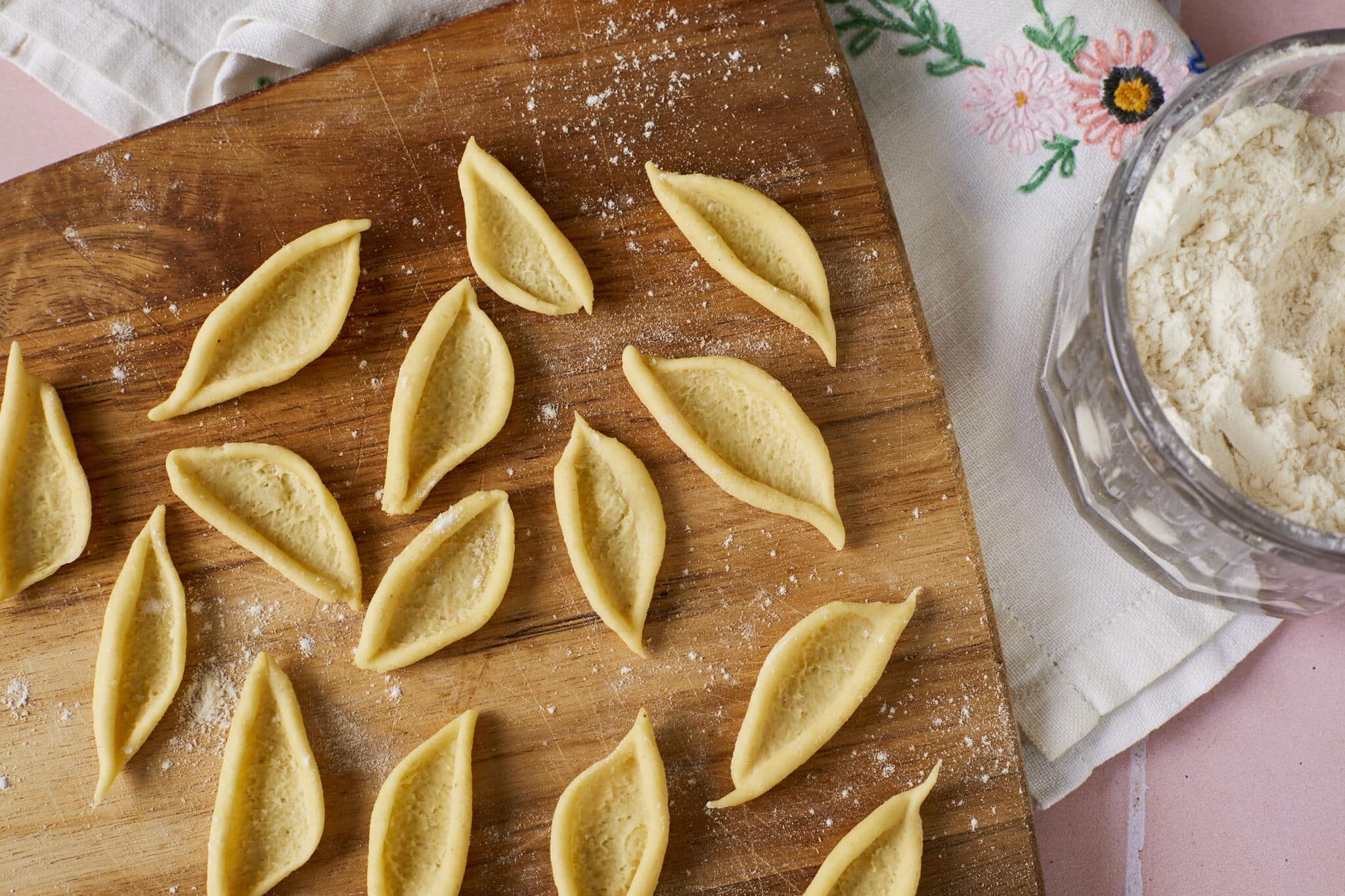
This post may contain affiliate links. Please see my full disclosure for details.
Hi Bold Bakers!
WHY YOU’LL LOVE THIS RECIPE: This Olive Leaf Pasta (Foglie d’Ulivo) is an elongated, shell-like pasta made from traditional, toothsome semolina dough. It’s the perfect choice if you want pasta that’s not super-long like fettuccine, but is big enough to work in a variety of dishes. If you’ve never attempted homemade pasta before, this is a perfect, easy-to-shape pasta to start with! It’s versatile, and its flat, curved shape seems like it was created just for capturing every bite of your favorite sauce.
This Olive Leaf Pasta Recipe (Foglie d’Ulivo) is made from my master Semolina Pasta Recipe. I can’t wait to share each variation with you, such as Busiate (spiral), Gnocchetti (ridged small elongated shell), Penne (smooth tubes), Trofie (twisted pasta), Cavatelli (mini hot dog bun), and Orecchiette (small ears).
Table of Contents
- What is Olive Leaf Pasta (Foglie d’Ulivo)
- Tools You Need for Olive Leaf Pasta
- Key Ingredients and Why
- How to Make Olive Leaf Pasta
- Can I Make Olive Leaf Pasta in Advance?
- How to Dry Fresh Pasta Correctly at Home
- How to Store Olive Leaf Pasta
- FAQs
- Gemma’s Pro Chef Tips
- More Pasta Recipes

What is Olive Leaf Pasta (Foglie d’Ulivo)
- Olive Leaf Pasta, or Foglie d’Ulivo, is a flat, elongated pasta. It is popular in both Liguria in Northern Italy and Puglia in Southern Italy.
- Its shape looks like the long, slender, oval leaves of the Mediterranean olive tree. It belongs to a pasta category called strascinati, from the Italian verb strascinare, meaning “to pull.” Strascinati are pasta shapes cut from ropes of pasta dough.
- Sometimes cooks add pureed fresh spinach to the dough to make this pasta look even more like olive leaves!
Tools You Need for Olive Leaf Pasta
- Food processor or bowl
- Measuring cups and measuring spoons
- Table knife
- Baking tray
Key Ingredients and Why
- Semolina flour
- Semolina flour is made from hard durum wheat, the species of wheat used to make pasta.
- This high gluten, high protein (13%) content gives semolina flour more durability and elasticity. That helps the pasta keep its shape while cooking and gives your pasta that wonderful al dente texture.
- It has a coarse, grainy texture, and is pale yellow in color from the carotenoids, the natural pigment found in durum wheat as well as in carrots and sweet potatoes.
How to Make Olive Leaf Pasta
Make the dough from my 2-Ingredient Semolina Pasta Recipe.
Shape the Olive Leaf Pasta
- Divide the dough into quarters and work with one section at a time. Keep the rest of the dough covered so that it doesn’t dry out. Roll the dough into a rope and cut it into 1 1/2 inch (4 cm) pieces.
- Take one piece of dough at a time, and roll so it’s tapered at both ends.
- Hold down one end of a piece of dough, and holding a table knife at a slight angle, press into the center of the dough lengthwise and drag down and away from you to create the leaf shape.
- As soon as you finish a piece, place it on the semolina-dusted baking tray.

Cook and store the Olive Leaf Pasta
- To ensure the pasta keeps its shape while cooking, let the pasta completely air-dry for 12 to 24 hours.
- When ready to serve, cook your pasta in a large pot of water with salt (for flavor and to prevent it from sticking) for 6 to 10 minutes.
Can I Make Olive Leaf Pasta in Advance?
Yes, you can make this pasta in advance. After it’s completely air-dried, it can be stored at room temperature in an airtight container for eight weeks.
How to Dry Fresh Pasta Correctly at Home
- Drying pasta correctly and thoroughly before storing it away is a very important step: if not done correctly the stored pasta will go moldy.
- Because it will be held at room temperature and not in the fridge, removing all the moisture is key to ensuring the safety and longevity of your pasta.
- Start by tossing the pasta with a small amount of semolina to keep the dough from sticking.
- Next, lay the pasta in a single layer on a baking sheet. You will need to let your pasta completely air-dry.
- This can take anywhere from 12-24 hours or longer, depending on the temperature and humidity of your kitchen.
- In hot countries, this step can be faster by putting the pasta in the sun, which is what I do.
How to Store Olive Leaf Pasta
- Store leftover cooked pasta in the refrigerator for up to three days. Drizzle a little olive oil on the pasta to keep it from sticking.
- Or dry the pasta in a single layer on the baking tray for several hours before transferring it to an airtight container to be stored at room temperature for up to 8 weeks.
- Alternatively, freeze raw fresh raw semolina pasta for up to eight weeks.
FAQs
-
How do I color Olive Leaf Pasta with spinach?
(This also explains how and how much spinach should be added to Foglie d’Ulivo.)
-
- Steam, puree, and spin or squeeze dry 10 ounces (283 grams) of fresh baby spinach.
- Blend with ⅓ cup (79ml/79g) of water.
- Mix in with the semolina flour. The dough should be elastic and smooth. If it’s too wet, add more semolina flour as necessary, and if it’s dry after the resting period, add water a few drops at a time.
-
Can I cook the pasta without drying it first?
The drying ensures that the pasta will keep its shape while cooking, and it also might be sticky if you try to boil it without drying it first.
-
Can I use my food dehydrator to dry my Olive Leaf Pasta?
Pasta is generally air-dried, however, you should be able to do it in a single layer in an oven or dehydrator at 135°F for about four hours, checking it at two hours to test it. The timing depends on the thickness of the pasta.
-
How will I know if my Olive Leaf Pasta is properly cooked?
Cook the pasta until plump and expanded, and the center no longer looks chalky or raw.
-
What are the most popular Olive Leaf Pasta (Foglie d’Ulivo) recipes?
- Burrata Foglie d’Ulivo: Top Olive Leaf Pasta with creamy burrata, chopped fresh tomato, and a sprinkle of red chili flakes, as they do in Italy.
- Foglie d’Ulivo ai Funghi: Make a sauce of earthy porcini mushrooms, garlic, olive oil, and white wine. It’s big on flavor and quick to put together.
- Olive Leaf Pasta and Herbs: In Puglia, this pasta is commonly adorned with chopped thyme, basil, oregano, and garlic with olive oil.
- Foglie d’Ulivo Ragu: A thick and meaty tomato sauce is a perfect and crowd-pleasing choice.
- Olive Leaf Pasta with Shrimp: Prepare this pasta the Apulian way—make it with seafood. Cook shrimp with garlic and olive oil, and squeeze on some lemon juice.

Gemma’s Pro Chef Tips
- Make the dough from my 2-Ingredient Semolina Pasta Recipe.
- This dough dries out quite easily, so be sure to always keep the dough covered in an airtight container (or in plastic wrap) when you are not working with it.
- This pasta is sometimes made with spinach. If you would like to try this, please find a specific recipe for this. The spinach has moisture which will replace some of the water required in the dough.
- Shape this pasta on an un-floured surface. If shaping becomes difficult, pass a damp cloth over your work surface and hands to help the dough stick a bit more.
- This pasta must dry completely before cooking for it to retain its shape.
- Even if thoroughly dried, this pasta must be stored in the refrigerator and cooked within two days.
- Store-bought fresh pasta often cooks in a few minutes but this heartier handmade version can take longer. Be sure to cook thoroughly!
- Pair this pasta with Roasted Garlic and Herb Compound Butter, Compound Butter, or Sun-Dried Tomato Compound Butter, you’ll be grand!
More Pasta Recipes
Olive Leaf Pasta Recipe (Foglie d’Ulivo)
Ingredients
- 1 recipe 2-Ingredient Semolina Pasta Recipe
Instructions
- Divide your Semolina Pasta Dough into quarters and work with one portion at a time, leaving the rest covered to keep it from drying out.
- On a clean, un-floured work surface, roll the dough into a rope about ¼ inch (16 mm) thick. Cut the rope into 1½ inch (4 cm) pieces.
- Working with one piece of dough at a time, roll the dough so that it is tapered at both ends. Gently hold down one end and using a table knife at a slight angle, press into the center of the dough lengthwise and drag it down and away from you to create the leaf shape.
- Transfer each piece to a baking tray dusted with semolina to let dry as you continue to shape the rest of the dough.
- Allow the dough to dry in a single layer on the baking tray for several hours to dry before cooking or transferring to an airtight container to be stored at room temperature for up to 8 weeks. (See my note above on ‘How to Dry Pasta Correctly at Home’)
- When ready to cook, bring a pot of salted water to a rolling boil. Add the pasta and cook until tender and fully cooked through, about 6-10 minutes. Cook time depends on thickness and shape so check for doneness before removing from the pot.






